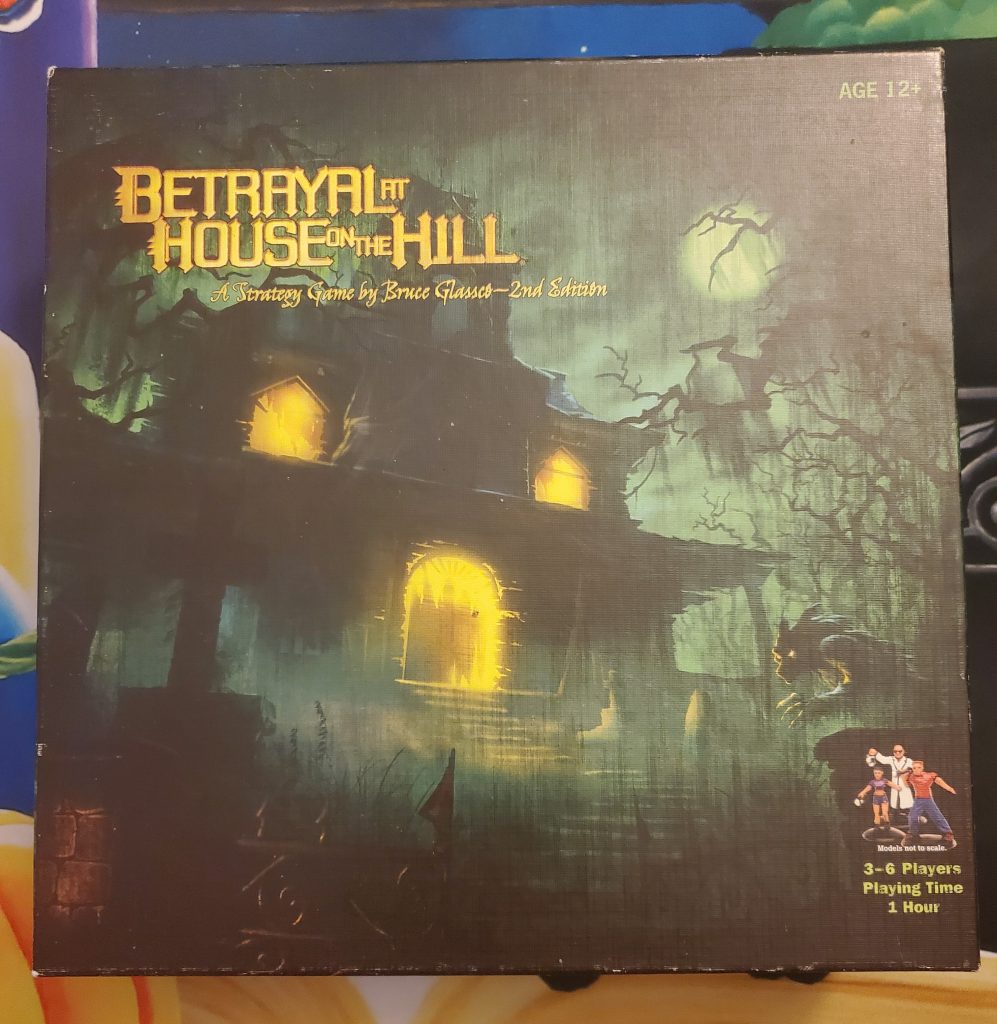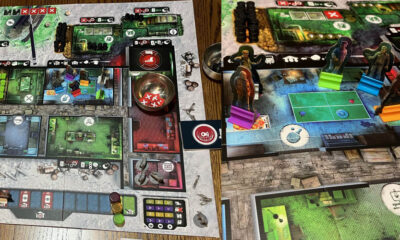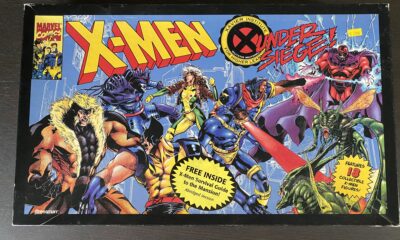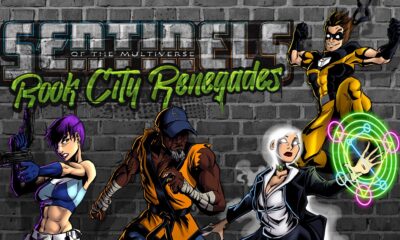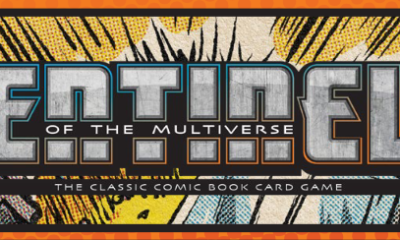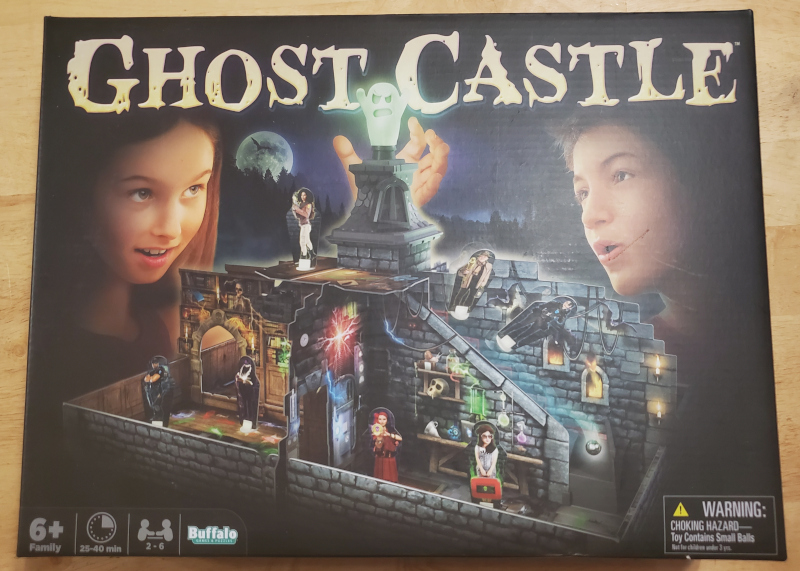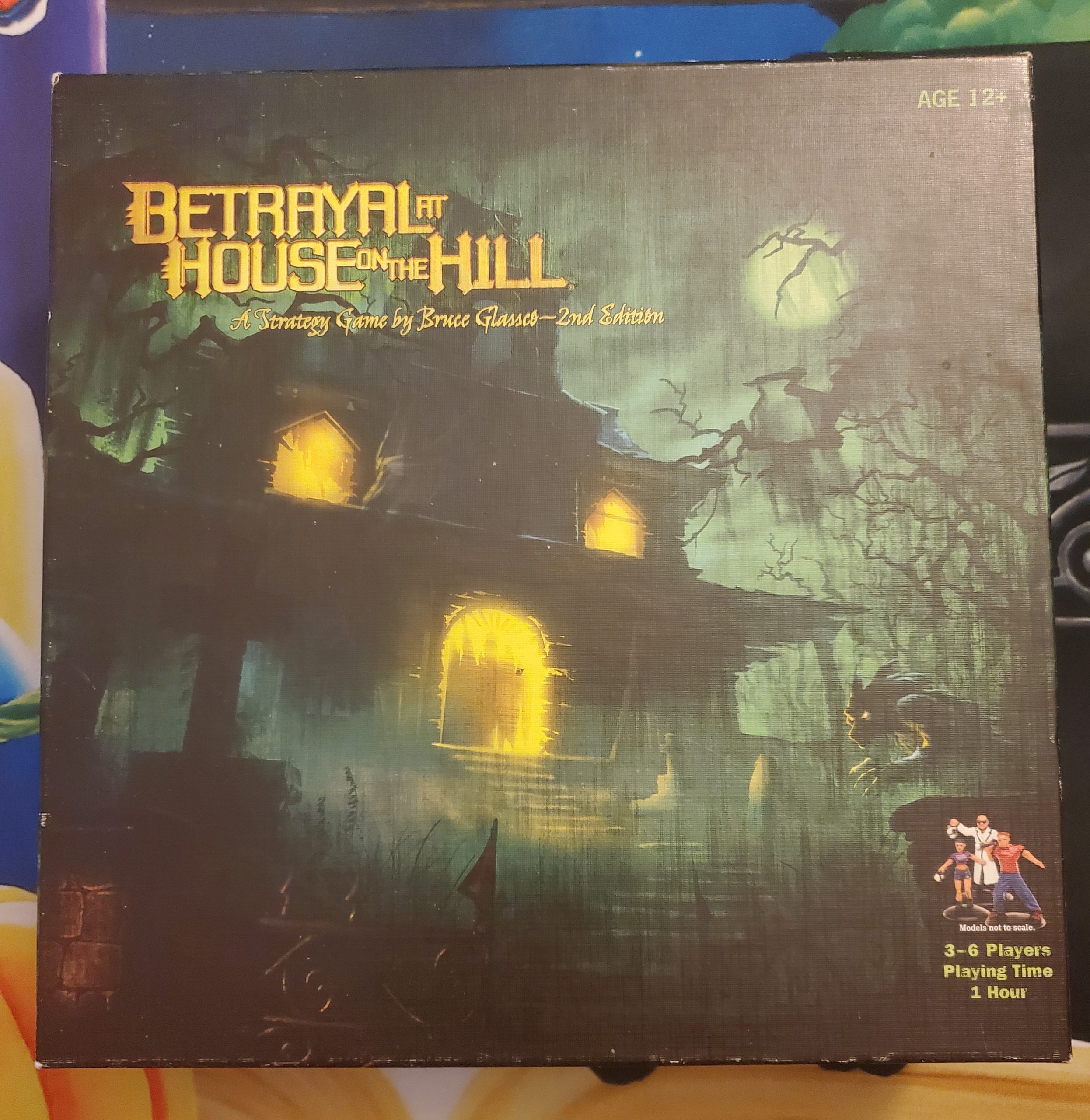
Betrayal at House on the Hill
More Videos
Published
2 years agoon
By
Leather Snow
Betrayal at House on the Hill is a game by Bruce Glassco where 3-6 players explore a spooky old mansion until things take a darker turn and one betrays the others.
Components

The game comes with 3 rulebooks, 1 for general game rules, 1 specifically for traitors, and 1 specifically for explorers. It also comes with 45 room tiles, 30 slider clips, 6 character cards, 6 character figures, 8 dice, 1 tracker (relevant only to certain scenarios), 22 item cards, 13 omen cards, 45 event cards, and 149 assorted tokens.
I love the tile-laying system and creating the board one piece at a time, however it does take up a lot of table space, especially since you have to manage three separate boards that keep growing.
The sliding clips that go on your character boards are a good idea in theory. The ones that actually fit are great, but most of them are very loose and slide around way too much. The slightest movement could cause you to completely lose track of your stats. I would recommend instead using a piece of paper, your phone, or maybe some dice instead. I’ve heard that there are a few unofficial apps that work really well for this but I haven’t personally tried any of them.
A lot of the marker tokens look pretty much the same, and there are a lot of them. It makes finding any specific token a huge pain.

The box is big. It generally fits everything pretty well, but it still takes up a lot of space. I think the space could have been used much more efficiently, especially considering that the extra components from the Widow’s Walk expansion have a hard time fitting in the box as-is but fit just fine when you use a different insert.
Gameplay
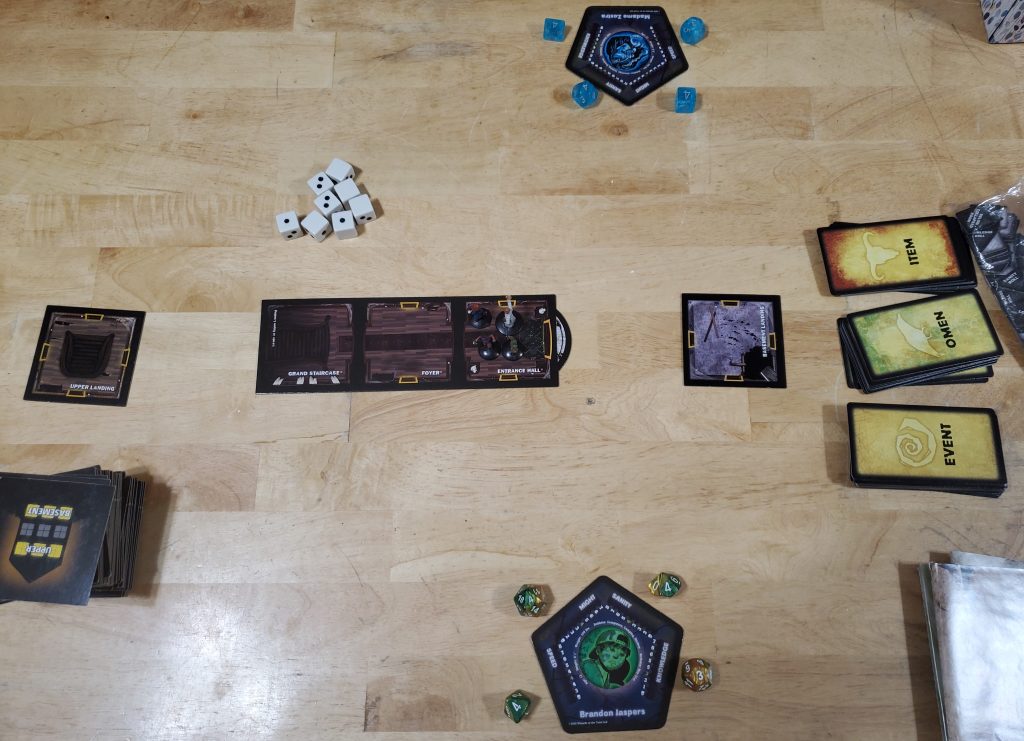
The first part of the game is the exploration phase. All players start in the entrance hall and explore the mansion by laying tiles to go to new rooms. As players travel through the house they will collect items, experience events, and encounter omens. Each time an omen is encountered, the players make a haunt roll. If the players roll greater than or equal to the current number of omens, they continue exploring. If they roll less than, the haunt phase begins.
Players consult the chart in the traitor’s tome to figure out what scenario they’re playing and which player is the traitor. The traitor will be given the traitor’s tome and sent off somewhere else while the explorers consult the survivor’s guide. Each scenario has a unique set of rules for both the traitor and the survivor, and each side often has rules that are to be kept secret from the other until it becomes relevant.
Thoughts
This game is a ton of fun and has lots of replayability. The board is never the same twice, and with the large number of scenarios it’s highly unlikely you’ll come across the same one twice in quick succession.
The theme is on-point. It captures the vibe of moving through a spooky mansion nicely. The impossible layouts that wouldn’t make any sense in a real house help mimic the feel of a horror movie. I’m reminded of The Shining, Rose Red, and that H.H. Holmes murder hotel.
There are some issues with the rules, though. For instance, several cards affect “outside rooms” and “rooms with windows” but the rulebook doesn’t specify what rooms these are. People can miss things, or simply have different interpretations, so it always helps to have terms laid out in the rules to settle any potential conflict. Because it’s a random game with a lot of corner-case interactions, it can be difficult to find answers to specific rules questions. There are also places where the rules aren’t explained very well, so while the rules are technically there, they’re hard to understand. An FAQ with a little extra detail would have really helped.
As a small nitpick, I don’t like that the haunt table is only in one book. I think it should have either been in both side’s rulebooks or just in the basic rules manual.
As fun as the randomness of the game can be, it can cause some trouble. Players can be stuck in rooms they can’t leave, find themselves in no-win scenarios, or otherwise just have some really rotten luck that can sour the game. To be fair, this is a problem in a lot of games, but because this game is explicitly designed to be very random, luck-based mayhem is both more common and more noticeable.
A few instances of particularly bad luck from the test game most of these photographs are from:
- Turn 1 I discovered the collapsed room & fell into the catacombs, which require a sanity roll of 6 or higher to leave. I placed myself on the side of the room opposite the basement landing. Next turn I explored and hit a dead end. I never left the catacombs.
- A player found the dog omen. The rules on the card say the dog can’t use rooms that require a roll. They found it in the junk room, a room that requires a roll to leave. The dog never left the junk room.
- The traitor had to get a certain number of monsters out of the house in order to win. They & their monsters were trapped in the basement with all of us, with only the mystic elevator (a room that allows you to roll to go to a random floor) as a way out. Only 1 monster left the basement.
Do You Need the Widow’s Walk Expansion?
The Widow’s Walk expansion comes with a brief rules sheet, 2 new rulebooks (1 for traitors, 1 for explorers), 20 room tiles, 8 omen cards, 11 item cards, 11 event cards, and 76 assorted tokens.
An important thing the Widow’s Walk expansion includes is some much-needed rules clarifications, such as specifying which rooms are outside & which have windows.
There are 50 more haunt scenarios to play, but they’re all written by different people, so the tone can vary a bit. While they are all mechanically interesting, thematically they’re very hit-and-miss. You also get an entire extra floor to run around on, and the new dumbwaiter mechanic which makes it a lot easier to move between floors.
Overall, the expansion isn’t required to fully enjoy the game, but at the very least you’ll want to look up the rulebook and note down those rules clarifications. If you find yourself playing the game a lot and want a little extra variety I’d say it’s worth it.
Verdict
This game gets four out of five cthulhus. The game is fun and the theming is spectacular but the rules are a little too clunky in places. You can check it out, along with the expansion and the Baldur’s Gate variant, at the links below, but remember that was are an Amazon affiliate and if you buy anything through the links provided we will get some $ back.
 (4 / 5)
(4 / 5)
You may like
Gaming
Stygian: Reign of the Old Ones (2019), a Game Review
Stygian: Reign of the Old Ones (2019) is a tactical role-playing video game developed by Cultic Games, evoking Lovecraftian horror.
Published
3 months agoon
April 30, 2024
Stygian: Reign of the Old Ones (2019) is a tactical role-playing video game developed by Cultic Games, evoking Lovecraftian and cosmic horror. Published by Fulqrum Publishing, this game is available through Linux, macOS, and Windows. This review will cover the $19.99 Steam release.
The Great Old Ones have awakened, exiling Arkham after the events of Black Day. Design your character and face the abominations of Arkham. Explore the 1920s through a Lovecraftian aesthetic as you unravel the secrets that plague Arkham, facing unknowable cosmic horror and malicious abominations.
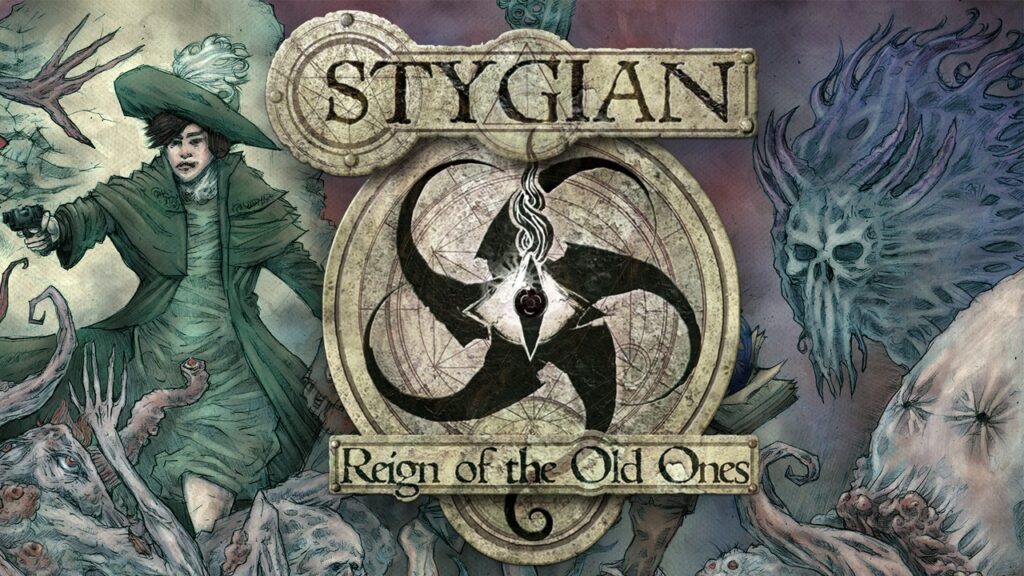
What I Like Stygian: Reign of the Old Ones
The depth of character creation starts the game off on the right foot. While appearance has various options, the game provides greater variety in motives, age, and origins, adding different gameplay elements. For example, age reflects lived experience and physical competency. The younger your character, the less experienced but more physically capable. This dynamic requires trial and error to find the best choice for you.
The paper cutout art provides a unique interpretation of a familiar (but stylish) Lovecraftian aesthetic. While not the most haunting execution of the Lovecraftian, it still manages to unsettle and unnerve while maintaining visual interest. That said, if the style doesn’t suit the player’s taste, Stygian: Reign of the Old Ones might leave that player wanting.
While I find the story engaging and the mysteries worth exploring, there’s a massive caveat to that claim. Regardless, if you fancy the Lovecraftian, few care as deeply and express as much knowledge of the genre as Cultic Games in this installment. This love and knowledge shines through in the often subtle allusions and references to the expanded universe. It may earn its place as the most Lovecraftian game out there.
The characters vary in interest and likability, but there’s usually something about them to add to the overall mystery. Naturally, this remains most evident in the companions that accompany the player on their journey.
In terms of horror, Stygian: Reign of the Old Ones achieves notable success. Despite the subjective points of aesthetics, the game brings out the most unsettling and uncomfortable elements of Lovecraftian and cosmic horror.

Tropes, Triggers, and Considerations
With an understanding of the Lovecraftian comes the question of how to deal with racism. Most properties try to remove this context, but Stygian: Reign of the Old Ones recognizes the text and era (the 1920s) with caricatures such as a lunatic in blackface. I won’t say it fully explores these toxic elements, but it’s not painted in a positive light.
Insanity and mental illness play a large role in the mechanics of the game, such as becoming a key component of casting spells. Loosely related, drug addiction and usage are mechanics with varying degrees of necessity depending on your build.
If these are deal breakers, perhaps give Stygian: Reign of the Old Ones a skip.
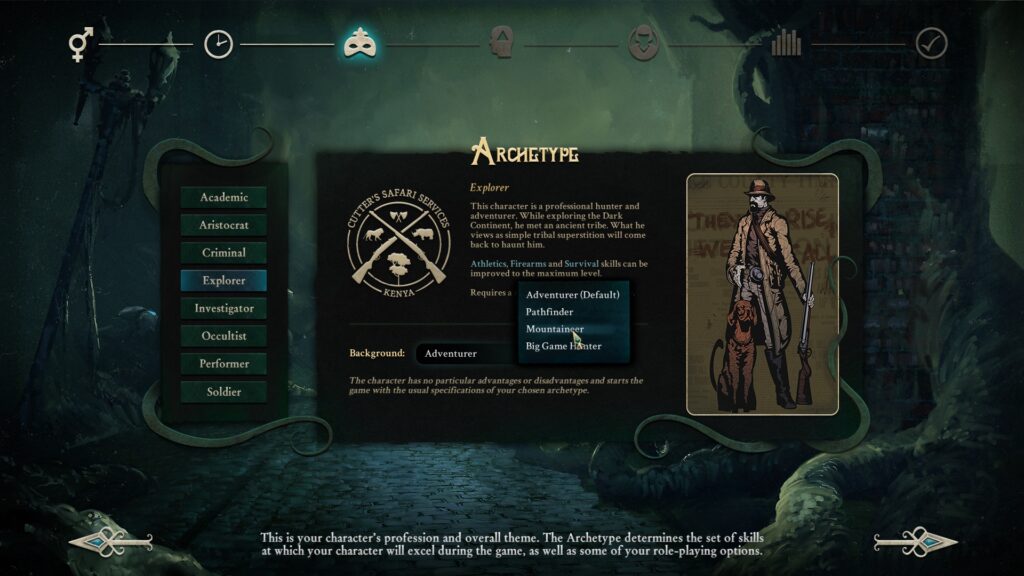
What I Dislike about Stygian: Reign of the Old Ones
In terms of story, this game is unfinished, leaving many plots, quests, and arcs with unsatisfying cliffhangers. My understanding is that Cultic Games planned to finish the game, but money ran out, and the focus shifted to an upcoming prequel. I imagine the goal is to use this new game to support a continuation. But that doesn’t change the unfinished state of Stygian: Reign of the Old Ones. The beginning and middle remain filled with content, but the final act (loosely stated) falls monstrously short.
While this unfinished state mostly affects content, I did run into game-breaking bugs. From my understanding, these bugs completely hinder progress. Most are avoidable, but some are unlucky draws.
It’s these points that make this a challenge to recommend, requiring the potential player’s careful consideration.

Final Thoughts
Stygian: Reign of the Old Ones accomplishes what many games fail, bringing to life the Lovecraftian. Unfortunately, this game falls short at the end and leaves game-breaking bugs as potential deterrents for full enjoyment. If what you read above entices you, it may be worth the investment. However, it’s unfair to recommend this game within its compromised state.
Gaming
Ashen (2018), a Game Review
Ashen (2018) is a souls-like action RPG developed by A44 and published by Annapurna Interactive available across all platforms.
Published
3 months agoon
April 30, 2024
Ashen (2018) is a souls-like action RPG game developed by A44 and published by Annapurna Interactive. This game provides a single-player and multiplayer experience with passive multiplayer mechanics. For this review, I am discussing the 39.99 Steam release, but it’s also available in the Epic Game Store, Xbox, Nintendo Switch, and PlayStation.
In this bitter world, your character seeks to make a home for yourself and others. This goal requires you to fight for every inch of land, building connections and alliances to maintain a thriving village. Venture further to make the world a more hospitable place, but know the further you travel, the greater the threats.
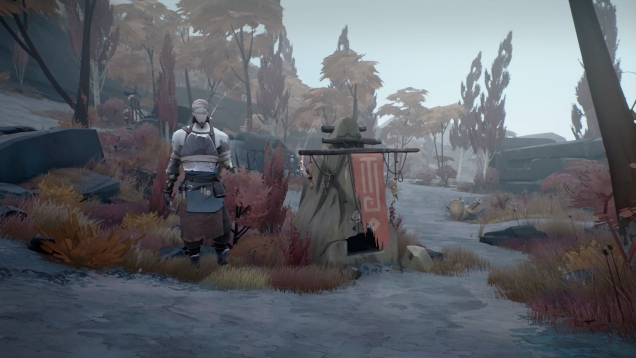
What I Like about Ashen
In 2017, Ashen earned a nomination for the Game Critics Awards’ “Best Independent Game.” It would later earn several more nominations in 2019. At the National Academy of Video Game Trade Reviewers Awards, it received nominations for “Game, Original Role Playing” and “Original Light Mix Score, New IP.” It was nominated for “Most Promising New Intellectual Property” at the SXSW Gaming Awards. Finally, at the Golden Joystick Awards, it earned a nomination for “Xbox Game of the Year.”
The multiplayer experience remains essential for Ashen, focusing on you and a partner venturing together to explore an open-world environment. However, the single-player experience is my focus and the game accounts for this gameplay. Ashen often pairs you with a villager who helps with the challenges.
The art style remains a plus throughout the gameplay. Though muted in colors and lacking finer details, the style creates a unique world that allows players to get lost along their journey. If the aesthetic doesn’t evoke that curiosity, then Ashen becomes hard to recommend.
Vagrant’s Rest and the inhabitants remain a strong incentive to continue on your journey. Seeing the progression of the town and building connections with the people provide the most rewarding experience.
In terms of horror, the art style often evokes an eerie atmosphere. However, I won’t go so far as to say the game is haunting. Instead, it evokes emotions that can unsettle and unnerve the gamer.

Thoughts and Considerations
The souls-like influence remains straightforward. Progression requires the player to defeat enemies and collect currency for weapons or certain item upgrades. Ashen simplifies and focuses its gameplay, reducing variety to polish its choices. The gameplay remains fluid, with a few hiccups that might be a computer issue.
If you prefer magic or defined classes, the gameplay doesn’t enable this variety. Item upgrades and choices define your playstyle, allowing most items to be playable at any stage of gameplay.
Weapons make a greater difference in playstyle. Most of these differences are self-evident (i.e. blunt weapons are slower but stun), but upgrades make any weapon viable. You pick an aesthetic and function, sticking with it until something better catches your eye.
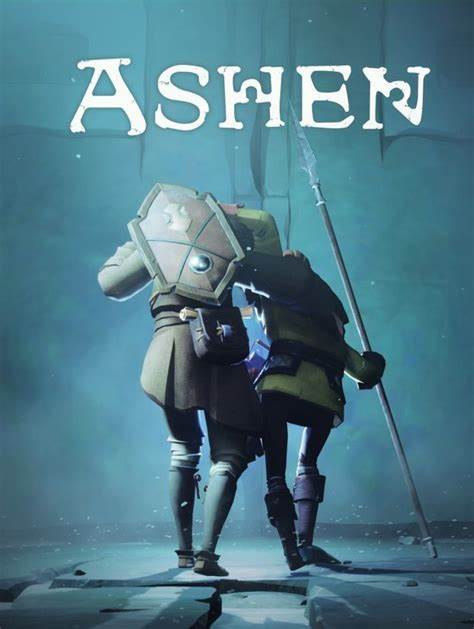
What I Dislike about Ashen
As mentioned, the game had some technical issues. I often assume this to be my computer, but I did note a few others mentioning similar issues. The gameplay remains fluid, so take this comment as a small point of consideration.
With limited roleplay options, liking the characters or art style remains essential for your time and money investment. As mentioned, the game doesn’t hold the variety of FromSoftware, which means their selling point comes from that unique art style and world.
Passive multiplayer is a major part of the marketing for Ashen. While I don’t mind this mechanic, 6 years after release reduces the overall impact. When so few wanderers appear in your game, it’s hard to see the overall appeal.

Final Thoughts
Ashen delivers a highly specialized souls-like experience, preferring to perfect what it can at the cost of variety. If the art appeals and the thirst for a souls-like has you wanting, Ashen stands as a strong contender. However, there are many contenders which make this hard to overtly recommend.
Gaming
I Have No Mouth, and I Must Scream (1995), a Game Review
I Have No Mouth, and I Must Scream (1995) is a point-and-click horror game based on Harlan Ellison’s award-winning short story.
Published
3 months agoon
April 29, 2024
I Have No Mouth, and I Must Scream (1995) is a point-and-click horror game based on Harlan Ellison’s award-winning short story of the same name. Developed by Cyberdreams and The Dreamers Guild, this adaptation brings a new perspective to a familiar story. I heard of free purchasing opportunities for this game but cannot verify the quality. For this review, I played the 5.99 Steam release.
Play as one of the remaining humans on earth: Gorrister, Benny, Ellen, Nimdok, and Ted. Each faces a unique challenge from their common torturer, the AI supercomputer known as AM. Chosen by AM to endure torment, these challenges require the participants to face their greatest failures and tragedies.
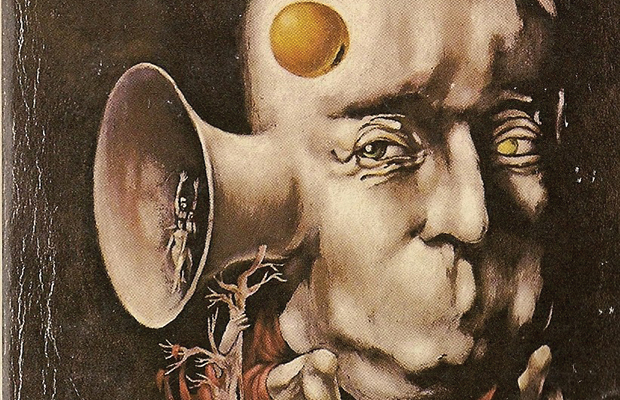
What I like about I Have No Mouth, and I Must Scream
Having experienced this story a few times, Harlan Ellison provides the most substantive execution of his vision and moral questions in this game. While all have individual merits, I assume the added content and context better dive into the relevant points he hoped to explore. He also played the voice of AM, giving us the emotional complexity of the machine as he saw it.
As the above comment indicates, I Have No Mouth, and I Must Scream remains a faithful adaptation with only one notable change. While that one change does reflect in that character’s journey, it uses that opportunity to the fullest. Where the short story left room for potentially inaccurate interpretations of the characters, this added context makes us better understand them.
The game’s writing remains a selling point for this story-driven experience. It dives further into the lore of the human characters and even allows further development of AM in the process. There are many ways to progress, and the multiple characters allow gamers to adventure further if stuck. That said, progressing individual characters to complete their journey remains essential for the true ending and experience.
As a point-and-click game made in 1995, I Have No Mouth, and I Must Scream holds up well. In many ways, it pushed the genre in its time with dynamic storytelling and game features. Harlan Ellison was someone who pushed boundaries to challenge himself and others. He saw the gaming industry as another opportunity to evoke story-driven art, a focus reflected here.

Thoughts, Triggers, and Considerations
I Have No Mouth, and I Must Scream adapts a dark and bleak story from an author notorious for his dark material. This game is no exception to that standard. Mental illness, sexual assault, genocide, and torture envelop the game. These elements are handled with attention but remain triggering to those sensitive to such dark material.
If these are deal breakers, I Have No Mouth, and I Must Scream will likely earn a skip.
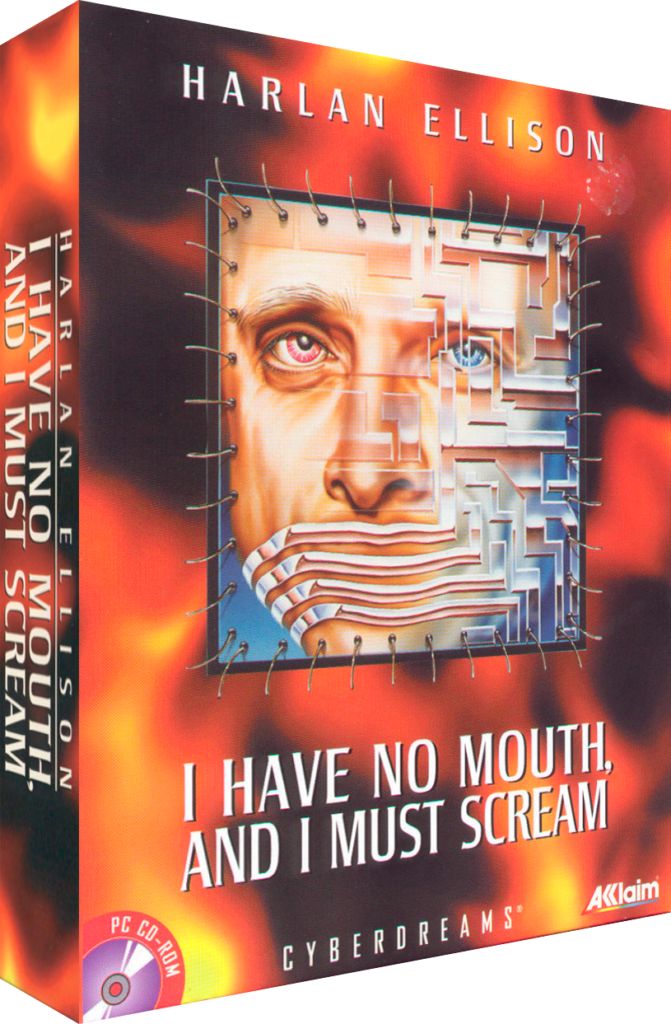
What I Dislike, or Considerations, for I Have No Mouth, and I Must Scream
While the short story remains a haunting example of fiction in every sentence, I Have No Mouth, and I Must Scream doesn’t evoke the same tension. It allows room to breathe or refocus on another character, which reduces the horror such a story evokes. While the characters participate in their torment, the loss of agency and hopelessness doesn’t translate in the execution.
Some mechanical and gameplay issues are noteworthy. For example, the saving mechanic remains dated, piling up if you save often or for specific reasons. Most of the mechanical issues stem from outdated UI from a gamer of a more modern era. Play it long enough, and elements start to click, but it needs that user investment.
Point-and-click caters to a niche audience, so modern gaming audiences aren’t inherently the demographic. The puzzle-solving and gameplay won’t win you over if the genre isn’t to your taste. Even within the genre, many of the puzzles remain challenging. For fans of the genre, this likely earns a positive merit. For those looking to continue the short story, this challenge will prove an obstacle.

Final Thoughts
I Have No Mouth, and I Must Scream provides a new opportunity for the award-winning story to reach new audiences and continue to grow. Not satisfied with repeating his story in a new medium, Harlan Ellison expands this bleak world through the point-and-click game. While not as haunting as the short story, this game provides the most context and development of any adaptation before it.


